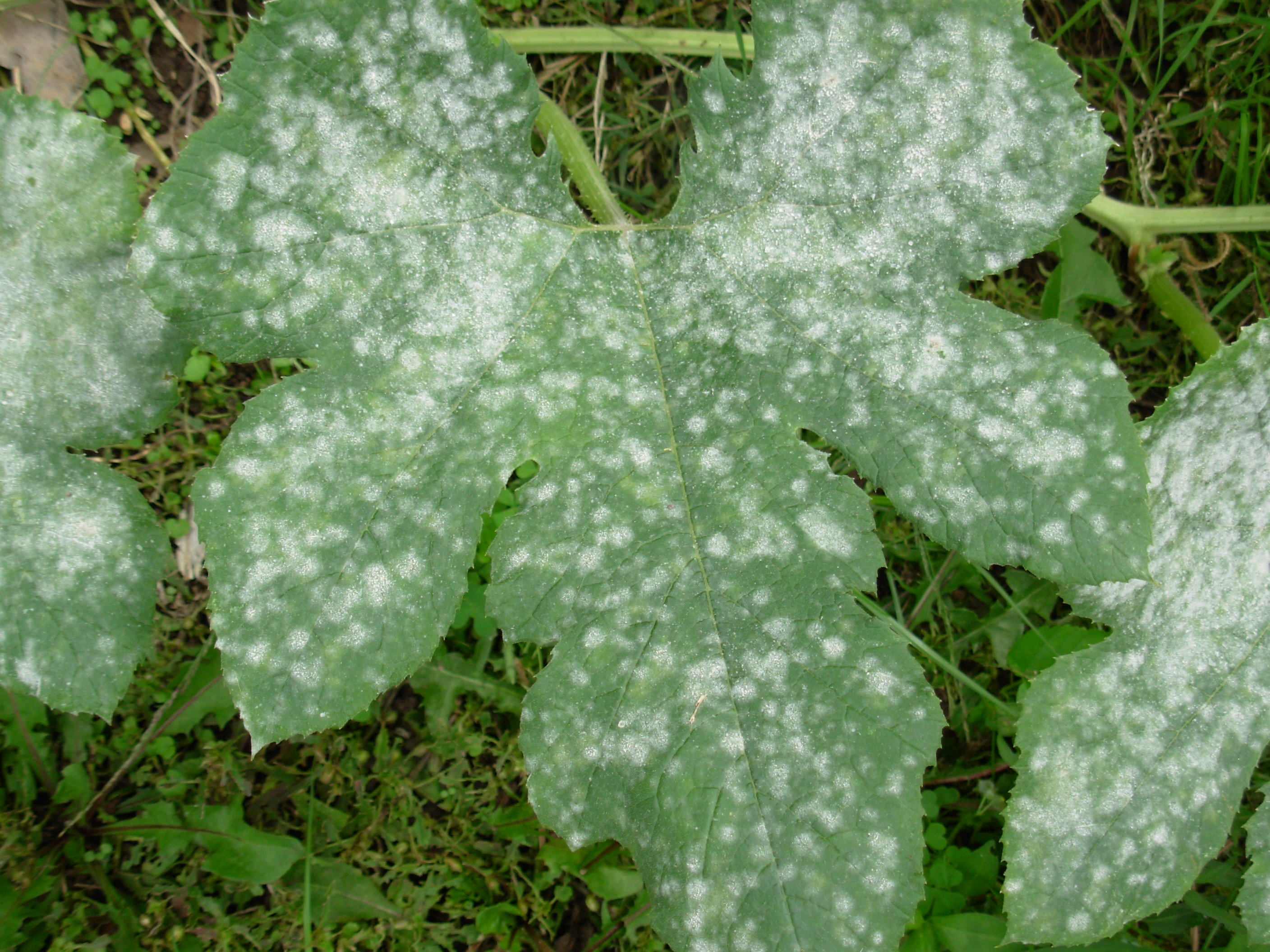Powdery mildew affects older leaves first. Photo: u.osu.edu
In many areas, it’s been a dry summer … just the condition powdery mildew (PM) likes … and cucurbits (cucumbers, melons, and squash, including pumpkins, zucchinis and patty pans) get more than their fair share of the disease, especially squash.
PM is pretty much the only plant disease that actually develops best on dry leaves. The perfect conditions? Humid air, no rain and moderate temperatures: 68–80°F (20–26°C).

On most plants, PM tends to be late season disease, rarely noted much before August. On cucurbits, powdery mildew first shows up when an apparent powdery residue covers the older leaves. It actually first shows up on the underside of the leaf, generally sight unseen, before migrating to the top side. Affected leaves then die back and that can sometimes lead to sun scald on the fruit underneath. Often it spreads to younger leaves and sometimes kills back the stems.
It’s worth noting first that PM is not one disease, it’s many diseases. In cucurbits alone, there are at least 2 different PM species in 2 different genera (Erysiphe cichoracearum and Podosphaera xanthii, formerly Sphaerotheca fuliginea) and each has several strains, all strictly adapted to cucurbits. You therefore needn’t worry that it will spread from your infected cucurbits to your other garden plants.

Many modern cucumber and melon varieties are naturally resistant to powdery mildew, although some heritage varieties are highly susceptible to it. However, there are fewer such choices in squashes. Even so, if you’ve had a problem one year, ideally, you’d look for a PM resistant variety for the following year’s harvest.
What to Do
Powdery mildew often appears so late in the season that often it doesn’t much affect the crop. With summer squash, for example, you’ve often pretty much finished harvesting before it shows up (or else you have so many zucchinis you really don’t care if you lose a few). Therefore, sometimes there is no need to react, except to remove any leaves that are so covered with mildew they turn yellow and are no longer carrying out photosynthesis.
Also, winter squash fruits often continue to mature in spite of the disease affecting their leaves. You’ll often see fields of pumpkins with damaged or dying leaves, for example, yet the fruits themselves will be fine.
With powdery mildew, the important thing is to slow down its progress. You can do so by spraying with any number of fungicides available at your local garden center (horticultural oil, neem, etc.). Make sure the fungicide is approved for edible plants. And always read the label before you apply: many fungicides, for example, should not be applied in extremely hot weather (temperatures above 85° F/32° C).

Home remedies like baking soda (5 mL/1 tsp. in 1 quart/1 liter of water, plus a few drops of insecticidal soap) or milk (1 part to 9 parts water), can also be quite effective.
Prevention Worth a Pound of Cure
With powdery mildew, it’s easiest to put your effort into prevention rather than treatment.
- Destroy infected plants at the end of the harvest.
- Practice crop rotation, not planting any cucurbits in the same spot for at least 4 years.
- Plant only resistant varieties. (This is such a simple solution that I’m always amazed so few gardeners look into it.) Good seed companies will mention which varieties are mildew resistant. If yours doesn’t, here are some choices: Squashes Resistant to Powdery Mildew.
- Plant cucurbits in full sun and space them appropriately (don’t overcrowd) to ensure good air circulation.
- Avoid excess fertilizer, especially ones rich in nitrogen.
- Water regularly in case of drought, as drought-stressed plants are more susceptible to PM, and, for once, don’t worry about moistening the leaves when you water, as PM develops best on dry leaves.
Seeing cucurbit leaves turn powdery white can be quite a shock the first time you see it, but since it doesn’t always affect the harvest to any degree, most gardeners learn to take it in stride. Personally, just choosing resistant varieties and carrying out simple crop rotation have given me all the mildew protection I need. That may be enough for you as well!
Article adapted from one published on September 1, 2016.

Pingback: Top 20+ White Fungus On Yellow Squash
Good point; that by the time the leaves succumb, the season is about done. My squash get it, but I have never worried about it. (Of course, it is not a very serious problem here anyway. I might worry more otherwise.)
Is this all the same for lilacs?
Lilacs also get powdery mildew, but a different species than the ones affecting squash and cucumbers. It is likewise a late-season disease rarely causing any damage to the plant, although it can be unsightly.